The Malignant Pleural Effusion Market is estimated to be valued at USD 5.1 billion in 2025 and is projected to reach USD 9.1 billion by 2035, registering a compound annual growth rate (CAGR) of 6.0% over the forecast period.
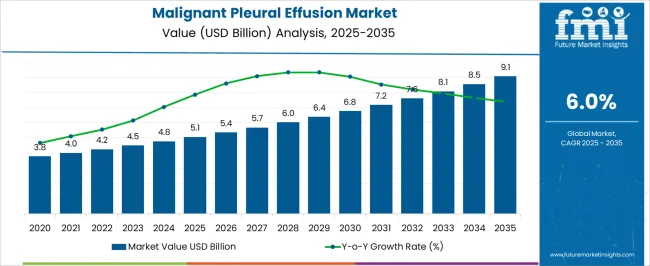
| Metric | Value |
|---|---|
| Malignant Pleural Effusion Market Estimated Value in (2025 E) | USD 5.1 billion |
| Malignant Pleural Effusion Market Forecast Value in (2035 F) | USD 9.1 billion |
| Forecast CAGR (2025 to 2035) | 6.0% |
The Malignant Pleural Effusion market is undergoing significant growth due to the increasing global burden of metastatic cancers, particularly lung and breast cancer, which are primary contributors to pleural effusion cases. Advancements in diagnostic tools and palliative care approaches have expanded the scope of early detection and effective symptom management, enhancing overall patient outcomes.
Leading oncology centers and clinical institutions are increasingly focusing on minimally invasive diagnostic techniques and therapeutic procedures that improve patient quality of life while reducing hospitalization time. Continuous improvements in imaging modalities and pleural biopsy accuracy, along with real-time cytological analysis, are driving timely and precise treatment decisions.
Growing emphasis on integrated oncology services within hospital settings, along with rising demand for cost-effective and scalable treatment solutions, is further fueling market expansion The market is expected to benefit from ongoing research in molecular diagnostics and targeted therapies, which are shaping a more personalized approach to disease management and setting the foundation for long-term market sustainability.
The market is segmented by Diagnosis, End User, and Treatment and region. By Diagnosis, the market is divided into Pleural Fluid Cytology, Imaging Tests, Pleural Thoracentesis, Immunohistochemical Tests, Pleural Biopsy, and Thoracoscopy/Pleuroscopy. In terms of End User, the market is classified into Hospitals, Ambulatory Clinics, and Others. Based on Treatment, the market is segmented into Thoracic Drainage and Pleurodesis, Systemic Therapy, Therapeutic Thoracentesis, and Indwelling Pleural Catheter. Regionally, the market is classified into North America, Latin America, Western Europe, Eastern Europe, Balkan & Baltic Countries, Russia & Belarus, Central Asia, East Asia, South Asia & Pacific, and the Middle East & Africa.
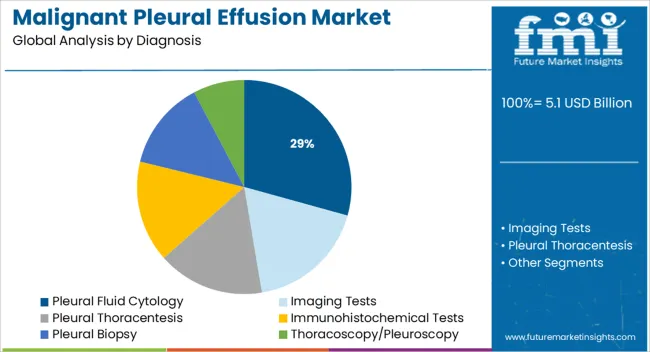
The pleural fluid cytology segment is expected to hold 29.3% of the Malignant Pleural Effusion market revenue share in 2025, making it the leading diagnostic approach. This growth is being supported by its non-invasive nature, low procedural risk, and high clinical utility in detecting malignant cells in pleural effusion samples.
It has been widely adopted in oncology-focused institutions and general hospitals due to its ability to offer rapid diagnostic results that guide immediate treatment decisions. Continued preference for this method has been strengthened by improvements in sample processing, liquid-based cytology techniques, and adjunct molecular markers that enhance detection sensitivity.
Clinical guidelines and institutional protocols increasingly recommend pleural fluid cytology as a first-line diagnostic step before more invasive procedures are considered The combination of diagnostic reliability, cost efficiency, and integration into routine clinical workflows has reinforced its prominent position in the diagnostic landscape for malignant pleural effusion.
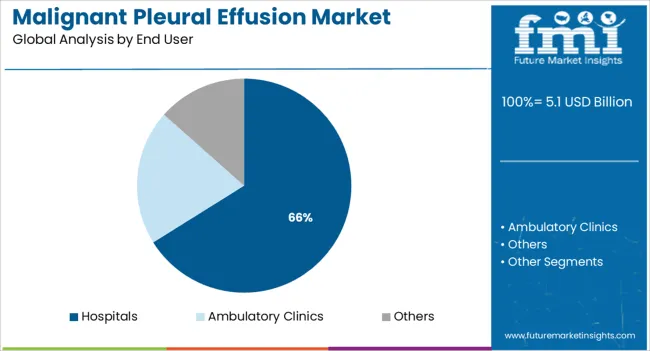
The hospitals segment is projected to account for 66.1% of the Malignant Pleural Effusion market revenue share in 2025, emerging as the most dominant end user. This growth is being driven by the availability of specialized oncology departments, advanced diagnostic infrastructure, and multidisciplinary teams capable of delivering comprehensive care. Hospitals have been the primary setting for managing pleural effusion cases that require both diagnostic evaluation and therapeutic intervention.
The preference for hospital-based care has also been influenced by their ability to offer pleuroscopy, image-guided thoracentesis, and inpatient monitoring for complex or high-risk patients. As regulatory standards and clinical protocols emphasize safety and quality assurance, hospitals are investing in integrated workflows that streamline diagnosis, treatment, and follow-up.
In addition, public and private hospital systems are expanding oncology services to accommodate rising cancer-related admissions, which has led to increased adoption of pleural effusion-specific diagnostic and treatment tools These institutional capabilities continue to support the segment’s leadership in the market.
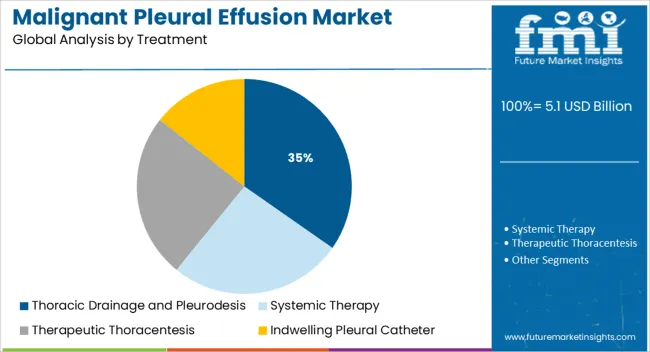
The thoracic drainage and pleurodesis segment is estimated to hold 34.7% of the Malignant Pleural Effusion market revenue share in 2025, positioning it as the leading treatment approach. Its dominance is attributed to its established clinical efficacy in relieving symptoms such as dyspnea and preventing recurrence of fluid buildup. Thoracic drainage remains a standard first-line intervention, while pleurodesis is being utilized for patients requiring long-term palliation.
The clinical preference for these procedures has been reinforced by improvements in catheter technology, the use of talc and other effective sclerosing agents, and increased procedural safety. These treatments are widely available in both inpatient and outpatient hospital settings, allowing for flexible care delivery tailored to disease progression.
Pleurodesis, in particular, has demonstrated cost-effectiveness by reducing repeat hospital visits and minimizing the need for continuous drainage With growing awareness of palliative care principles and the need for patient-centric treatment models, this segment continues to hold a critical role in therapeutic management strategies for malignant pleural effusion.
According to market research and competitive intelligence provider Future Market Insights. the market for Malignant Pleural Effusion reflected a value of 4% during the historical period, 2020 to 2025. Various factors such as awareness in wellness and health, the diagnostics, and pathology segment are improving in developing countries nowadays which grows the therapeutics market. The research and development activities in the field like emerging novel therapeutics, increasing the efficacy of medicine as well as treatment.
Selling campaigns initiated by global players are growing the market progressively. Increasing focus by government organizations and private agencies like WHO and pharmaceutical companies to create awareness of pleural effusions is fuelling market growth. Thus, the market for Malignant Pleural Effusion is expected to register a CAGR of 6% in the forecast period 2025 to 2035.
Increasing Incidence of Malignant Pleural Effusion disease post covid-19 pandemic to push the market growth
The increasing prevalence of Malignant Pleural Effusion disease is one of the biggest drivers of the market. After The covid-19 pandemic hit the world, various research was conducted to find a correlation between Covid-19 infection and pleural effusion.
For instance, the article “Prevalence and Clinical Outcomes of Pleural Effusion in Covid-19 Patients: A Systematic Review and Meta-Analysis” published in January 2025 showed that pleural effusion is related to the risk and prognosis of Covid-19 disease.
Pleural effusion can be used as a prognostic indicator to assess the likelihood of poorer outcomes in Covid-19 patients; as a result, the researchers of the above-mentioned research article advised that hospitalized Covid-19 patients with pleural effusion be handled promptly. Considering these in-depth studies, the pandemic showed a considerable impact on the market studied.
Expensive Cost of Treatment to restrict Market Growth
The expensive treatment of Malignant Pleural Effusion, less awareness of Malignant Pleural Effusion disease, and insubstantial treatment options are hampering the market growth.
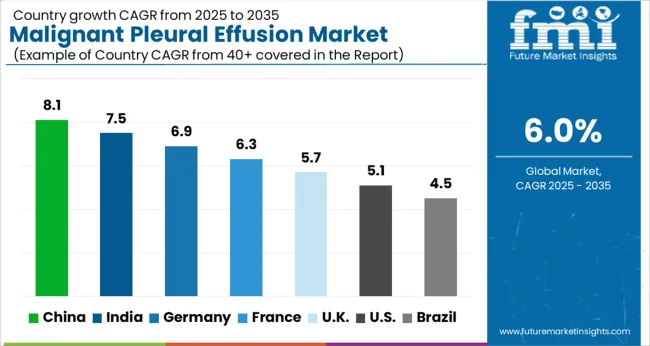
Improvement in healthcare spending propelling the growth of Malignant Pleural Effusion in Asia Pacific
The Asia Pacific is expected to exhibit the fastest growth rate of all regions over the forecast period, with a CAGR of 5% during the forecast period. The growth is owed to increased awareness, significant increases in healthcare spending, and a rising frequency of malignant pleural effusion in the region.
Asia Pacific is an emerging market due to the increase in point care approach to health & care. An increasing number of hospitals in India and China makes a promising market for the Pleural effusions treatment market worldwide.
High Prevalence of various diseases shaping the landscape for Malignant Pleural Effusion in North America
North America is anticipated to acquire a market share of about 45% in the forecast period. This growth is attributable to the rising prevalence of pleural effusions in the region. An article published by WebMD LLC in October 2024 stated that approximately 1.5 million pleural effusions are diagnosed in the United States every year and in industrialized countries, the estimated prevalence of pleural effusion is 320 cases per 100,000 people.
This ever-widening burden of the condition on the healthcare facilities is creating demand for the treatment globally, expected to fuel the market growth during the analysis period. Furthermore, the rising geriatric population is leading to an increase in the prevalence of various diseases, growing the health and economic burden.
As per the American Heart Association data updated in April 2025, nearly 115 million people in have hypertension, 100 million have obesity, 92 million have prediabetes, 26 million have diabetes, and 125 million have atherosclerotic cardiovascular diseases (CVD) United States, which are known to be the risk factors for the development of heart failure. Thus, the high burden of various diseases creates the risk of pleural effusions among the target population in the United States.
Key start-up players in the Malignant Pleural Effusion market are-
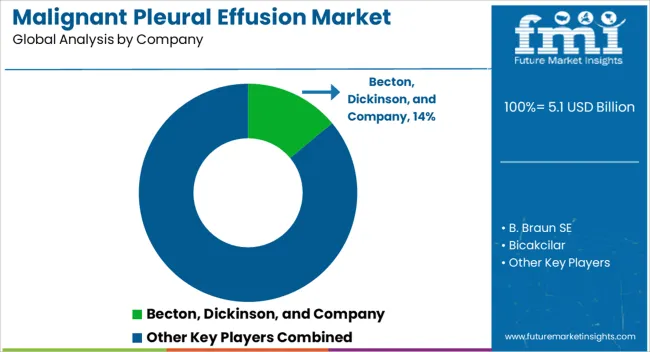
Key players in the Malignant Pleural Effusion market are Allakos, iCo Therapeutics, Akari Therapeutics, and Santen.
| Report Attribute | Details |
|---|---|
| Market Value in 2025 | USD 5.1 billion |
| Market Value in 2035 | USD 9.1 billion |
| Growth Rate | CAGR of 6% from 2025 to 2035 |
| Base Year for Estimation | 2025 |
| Historical Data | 2020 to 2025 |
| Forecast Period | 2025 to 2035 |
| Quantitative Units | Revenue in USD Million and CAGR from 2025 to 2035 |
| Report Coverage | Revenue Forecast, Volume Forecast, Company Ranking, Competitive Landscape, Growth Factors, Trends, and Pricing Analysis |
| Segments Covered | Treatment, End User, Diagnosis, Region |
| Regions Covered | North America; Latin America; Western Europe; Eastern Europe; Asia Pacific; Middle East & Africa (MEA) |
| Key Countries Profiled | The USA, Canada, Brazil, Mexico, BENELUX, France, Germany, Italy, Nordics, Spain, The UK, Poland, Russia, India, Malaysia, Singapore, Thailand, Australia, New Zealand, GCC, South Africa, Israel |
| Key Companies Profiled | B. Braun SE; Becton, Dickinson, and Company; Bicakcilar; Biometrix; Cook Medical; Grena; Redax; Rocket Medical; Smith Medical; Taiho Pharmaceutical Co. Ltd. |
| Customization | Available Upon Request |
The global malignant pleural effusion market is estimated to be valued at USD 5.1 billion in 2025.
The market size for the malignant pleural effusion market is projected to reach USD 9.1 billion by 2035.
The malignant pleural effusion market is expected to grow at a 6.0% CAGR between 2025 and 2035.
The key product types in malignant pleural effusion market are pleural fluid cytology, imaging tests, pleural thoracentesis, immunohistochemical tests, pleural biopsy and thoracoscopy/pleuroscopy.
In terms of end user, hospitals segment to command 66.1% share in the malignant pleural effusion market in 2025.






Full Research Suite comprises of:
Market outlook & trends analysis
Interviews & case studies
Strategic recommendations
Vendor profiles & capabilities analysis
5-year forecasts
8 regions and 60+ country-level data splits
Market segment data splits
12 months of continuous data updates
DELIVERED AS:
PDF EXCEL ONLINE
Malignant Ascites Market Size and Share Forecast Outlook 2025 to 2035
Malignant Infantile Osteopetrosis Market
Pleural Diseases Therapeutics Market – Drug Trends & Future Outlook 2025 to 2035
Pleural Cavity Drainage Market
Pleural Effusions Treatment Market

Thank you!
You will receive an email from our Business Development Manager. Please be sure to check your SPAM/JUNK folder too.
Chat With
MaRIA